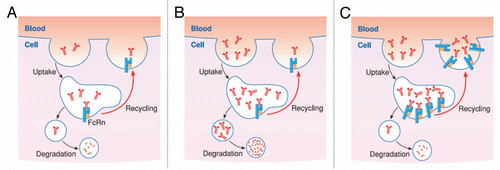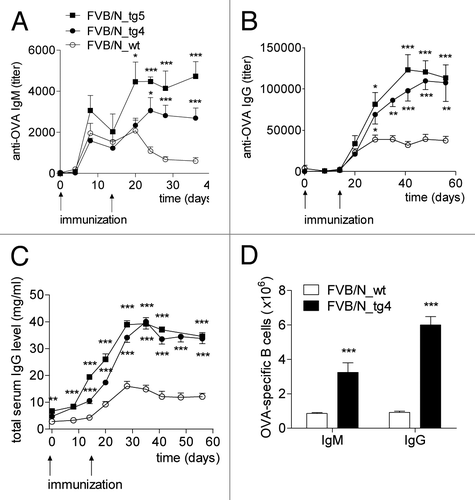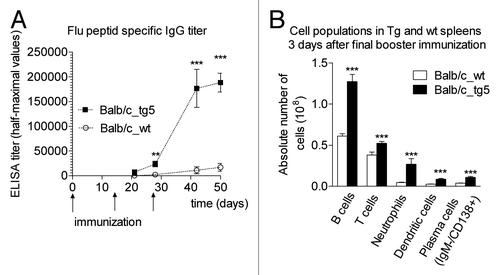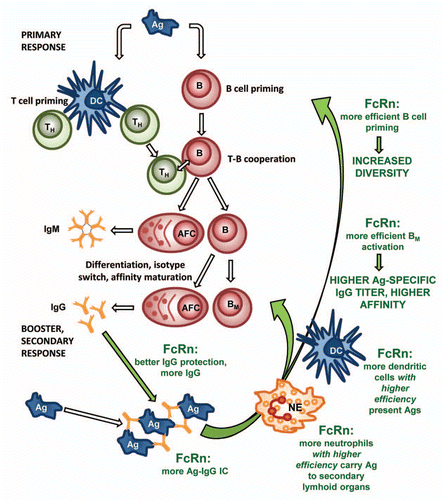Figures & data
Figure 1 (A) The multiple functions of FcRn are dependent on its ability to sort monomeric IgG away from lysosomal degradation within cells and release bound cargo during exocytic events at plasma membrane. (B) The fact that FcRn salvage pathway is saturable is a well-known phenomenon referred to as fractional catabolic rate and caused by the fact that the pool of FcRn available in cells to recycle or transport its ligand can be limited. Thus, when FcRn is fully saturated, the unbound ligand is cleared, primarily through lysosomal degradation. (C) The prolonged IgG half-life results of the transgenic mice that overexpress FcRn clearly suggest a correlation between the levels of expression of FcRn and the protection of IgG.

Figure 2 bFcRn overexpression resulted in a robust augmentation of the immune response in tg mice. FVB/N_tg4, FVB/N_tg5 (FVB/N transgenic mice carrying 4 and 5 copies of the bFcRn, respectively) and wild-type mice were immunized i.p. with OVA in CFA and challenged 14 days later with OVA in IFA. (A) OVA-specific IgM and (B) OVA-specific IgG titers were nearly tripled during the secondary immune response in FVB/N_tg4 and FVB/N_tg5 mice compared with the wild-type animals. (C) Transgenic mice produced significantly higher amounts of total IgG compared to the wild-type mice. (D) ELISPOT assays were performed to test for the presence of OVA-specific B cells. The number of OVA-specific cells was calculated taking account of the total spleen cell number. Multiple-fold increase of OVA-specific IgM and IgG producer cells was detected in the spleen of FVB/N_tg4 mice compared with wild-type controls. Significance levels indicate the difference between the tg and wild-type mice. Values shown are the mean ± SEM. (*p < 0.05; **p < 0.01; ***p < 0.001). All the experiments were repeated three times with similar results (Figure is reproduced from reference Citation24 with permission. Copyright 2011. The American Association of Immunologists, Inc.).

Figure 3 Immunization with HA2-KLH elicits potent anti-peptide immune response in bFcRn tg mice. (A) HA2-specific IgG titers showed a substantial increase in tg mice compared to the negligible IgG titers of wild-type mice. (B) Absolute number of B cells, T cells, neutrophils, dendritic cells and plasma cells were significantly higher in the spleen of transgenic animals as measured by FACS analysis. Values shown are the mean ± SEM. (*p < 0.05; **p < 0.01; ***p < 0.001). All the experiments were repeated twice with similar results (Figure is reproduced from reference Citation22 with permission).

Figure 4 A proposed model for the role of FcRn overexpression in augmented humoral immune response. Better IgG rescue results in higher level of antigen-specific IgG in immunized transgenic animals which leads to the formation of more antigen-IgG ICs. A higher level of ICs and their increased phagocytosis by the transgenic neutrophils (NE) results in a much greater influx of these cells into the regional secondary lymphoid organs, thus potentiating the humoral immune response. Transgenic dendritic cells (DC) that overexpress FcRn phagocytose and present antigens more efficiently to T helper cells (TH) when loaded with antigen-IgG ICs. The higher number of DCs in transgenic FcRn animals compared to the wild-type controls after immunization suggests that these cells are more abundant and active in spleen of transgenic mice and very likely contribute to the augmented immune response observed. Based on these observations, we suggest that the overexpression of the FcRn does more than protect antigen-specific IgG from degradation. It also enhances the priming of naïve B cells, the expansion of antigen-specific memory B cells (BM) and plasma cells (antibody forming cells; AFC) in the secondary lymphoid organs. This results in a more diverse humoral immune response, a higher titer and higher affinity of antigen-specific IgG. (Green texts and arrows indicate cells and effects that contribute in augmenting the humoral immune response by FcRn).
